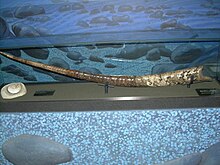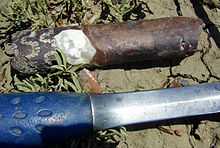Baculites
| Baculites Temporal range:UpperCretaceousto LowerPaleocene
| |
|---|---|

| |
| Baculitesfossils from South Dakota. Some still have traces of the originalnacre(shells). | |
| Scientific classification | |
| Domain: | Eukaryota |
| Kingdom: | Animalia |
| Phylum: | Mollusca |
| Class: | Cephalopoda |
| Subclass: | †Ammonoidea |
| Order: | †Ammonitida |
| Suborder: | †Ancyloceratina |
| Family: | †Baculitidae |
| Genus: | †Baculites Lamarck,1799 |
| Type species | |
| †Baculites vertebralis | |
| Species | |
|
See text | |
Baculitesis an extinct genus of heteromorphammonitecephalopodswith almost straight shells. The genus, which lived worldwide throughout most of theLate Cretaceous,and which brieflysurvivedtheK-Pg mass extinction event,was named byLamarckin 1799.[3][4]
Life
[edit]Shell anatomy
[edit]The adult shell ofBaculitesis generally straight and may be either smooth or with sinuous striae or ribbing that typically slant dorso-ventrally forward. The aperture likewise slopes to the front and has a sinuous margin. The venter is narrowly rounded to acute while the dorsum is more broad. The juvenile shell, found at the apex, is coiled in one or two whorls and described as minute, about 1 centimetre (0.39 in) in diameter. AdultBaculitesranged in size from about 7 centimetres (2.8 in) (Baculites larsoni) up to 2 metres (6.6 ft) in length.
As with otherammonites,the shell consisted of a series of camerae, or chambers, that were connected to the animal by a narrow tube called a siphuncle by which gas content and thereby buoyancy could be regulated in the same manner asNautilusdoes today. The chambers are separated by walls called septa. The line where each septum meets the outer shell is called the suture or suture line. Like other trueammonites,Baculiteshave intricate suture patterns on their shells that can be used to identify different species.

One notable feature aboutBaculitesis that the males may have been a third to a half the size of the females and may have had much lighter ribbing on the surface of the shell.
Orientation
[edit]The shell morphology ofBaculiteswith slanted striations or ribbing, similarly slanted aperture, and more narrowly rounded to acute keel-like venter points to its having had a horizontal orientation in life as an adult. This same type of cross section is found in much earliernautiloidssuch asBasslerocerasandClitendocerasfrom theOrdovicianperiod, which can be shown to have had a horizontal orientation. In spite of this, some researchers have concluded that Baculites lived in a vertical orientation, head hanging straight down, since lacking an apical counterweight, movement was largely restricted to that direction. More recent research, notably by Gerd Westermann, has reaffirmed that at least someBaculitesspecies in fact lived in a more or less horizontal orientation.[5]
Ecology
[edit]From shell isotope studies, it is thought thatBaculitesinhabited the middle part of the water column, not too close to either the bottom or surface of the ocean. In some rock depositsBaculitesare common, and they are thought to have lived in great shoals. However, they are not known to occur so densely as to be rock-forming, as do certain other extinct, straight-shelled cephalopods (e.g.,orthoceridnautiloids). Studies on exceptionally preserved specimens have revealed aradulabysynchrotronimagery.[6]The results suggest thatBaculitesfed on pelagiczooplankton(as suggested by remains of a larvalgastropodand a pelagicisopodinside the mouth).[7]
Convergent evolution
[edit]Baculitesand relatedCretaceousstraightammonitecephalopods are often confused with the superficially similarorthoceridnautiloidcephalopods. Both are long and tubular in form, and both are common items for sale in rock shops (often under each other's names). Both lineages evidently evolved the tubular form independently, and at different times in earth history. Theorthoceridnautiloidsmostly lived much earlier (common during thePaleozoicEra, possibly going extinct in theEarly Cretaceous)[8]thanBaculites(LateCretaceous-Danianonly). The two types of fossils can be distinguished by many features, most obvious among which is the suture line: it is simple in orthocerid nautiloids and intricately folded inBaculitesand related ammonoids.
Species distribution
[edit]


Cenomanian:
Baculites gracilisis known from the CenomanianBritton Formation.
Turonian:
Baculites undulatus,from the upper Turonian of Europe.[9]
Campanian:
The lower part of the Campanian stage (Upper Cretaceous) in the Western Interior of North America has yieldedBaculites gilberti,earlyB. perplexus,B. asperiformis,B. maclearni,andB. obtusus,followed temporally by lateBaculites perplexusand then byBaculites scotti.The upper part of the upper Campanian has yielded, from older to younger,B. compressus,B. coneatus,B. reesidei.B. jenseni,andB. ellasi,followed sequentially in the lower Maastrictian byBaculites baculus,B. grandis,andB. clinolobatis.[10][11]
Baculites pacificumis known from the Campanian of Vancouver Island, British Columbia, andBaculites leopoliensisfrom the Upper Campanian of Europe.[12]
Maastrichtian/Danian:
The type species,Baculites vertebralisis from the upper Maastrichtian and Danian, and is one of thevery last species of ammonites.Findings in Denmark and the Netherlands suggest the species survived theK-Pg mass extinction event,albeit being restricted to theDanian.[3][13][14]Baculites ancepsis also known from Europe, although only from the Upper Maastrichtian.[12]

Baculites ovatusis known from the Maastrichtian deposits ofRipley FormationinMcNairy County, Tennessee,andSevern FormationinPrince George's County, Maryland.[15]
Cultural significance
[edit]Baculitesfossils are very brittle and almost always break. They are most commonly found broken in half or several pieces, usually along suture lines. Individual chambers found this way are sometimes referred to as "stone buffaloes" (due to their shapes), though the Native-American attribution typically given as part of the story behind the name is likely apocryphal.[clarification needed]The Blackfoot have oral traditions that tell a story of the Iniskimm (Buffalo Calling Stone). They are still in use today by Indigenous peoples.
Baculites ovatus,the first species ofBaculitesdescribed in the Americas, was described byThomas Sayin 1820[16]from a single specimen from theNavesink FormationinAtlantic Highlands, New Jersey.The specimen was later illustrated bySamuel George Morton,who published an etching in 1828.[17]After the death of the specimen's owner, the Quaker scientistReuben Haines III,in 1831, the specimen was lost for 180 years until it was rediscovered at Haines's home, the historicWyck House,in 2017 by Matthew Halley.[18]
References
[edit]- ^Lamarck, J. P. B. A. de M. de (1801):Systeme des Animaux sans vertebres.The author; Deterville, Paris, vii + 432 pp.
- ^Meek, F. B. (1876): A report on the invertebrate Cretaceous and Tertiary fossils of the upper Missouri country. In Hayden,F. V.Report of the United States Geological Survey of the Territories,9, lxiv + 629 pp., 45 pis
- ^abLandman, Neil H.; Goolaerts, Stijn; Jagt, John W.M.; Jagt-Yazykova, Elena A.; Machalski, Marcin (2015), Klug, Christian; Korn, Dieter; De Baets, Kenneth; Kruta, Isabelle (eds.),"Ammonites on the Brink of Extinction: Diversity, Abundance, and Ecology of the Order Ammonoidea at the Cretaceous/Paleogene (K/Pg) Boundary",Ammonoid Paleobiology: From macroevolution to paleogeography,Topics in Geobiology, Dordrecht: Springer Netherlands, pp. 497–553,doi:10.1007/978-94-017-9633-0_19,ISBN978-94-017-9633-0,retrieved2024-02-13
- ^Lamarck, J. P. B. A. de M. de (1799): Prodrome d'une nouvelle classification des coquilles.Mem. Soc. Hist. Nat.Paris,(1799), 63-90.
- ^Westermann, G. E. G. (1996). Ammonoid life and habitat. In N. H. Landman, K. Tanabe, and R. A. Davis (editors),Ammonoid Paleobiology,pp. 607–707. New York: Plenum Press.
- ^Kruta, I.; Landman, N.; Rouget, I.; Cecca, F.; Tafforeau, P. (2011). "The Role of Ammonites in the Mesozoic Marine Food Web Revealed by Jaw Preservation".Science.331(6013): 70–72.Bibcode:2011Sci...331...70K.doi:10.1126/science.1198793.PMID21212354.S2CID206530342.
- ^Neil H. Landman, Richard Arnold Davis, Royal H. Mapes (2007).Cephalopods. Present and Past: New Insights and Fresh Perspectives. Chapter 13: Jaws and Radula ofBaculitesfrom the Upper Cretaceous (Campanian) of North America(PDF).Springer. pp. 257–298.ISBN978-1-4020-6806-5.Archived fromthe original(PDF)on September 12, 2013.
{{cite book}}:CS1 maint: multiple names: authors list (link) - ^Doguzhaeva, Larisa (1994-01-01)."An Early Cretaceous orthocerid cephalopod from North-Western Caucasus".Palaeontology.37:889–899.
- ^"Baculites undulatusd'Orbigny, 1847 ".crioceratites.free.fr.Archivedfrom the original on February 13, 2024.Retrieved2024-02-13.
- ^"Ammonite Zones (International Stratigraphy Standards)".North American Research Group.Archivedfrom the original on October 4, 2023.
- ^"Baculitidae (Gill 1871)".Jdsamonites.Archivedfrom the original on June 5, 2023.
- ^ab"Baculitidae GILL 1871".www.ammonites.fr.Archived fromthe originalon May 27, 2022.
- ^"Bulletin Volume 52 – 2005".Dansk Geologisk Forening(in Danish). 2005-05-25.doi:10.37570/bgsd-2005-52-08.Retrieved2024-02-13.
- ^W. M. Jagt, John (2012-01-01)."Ammonieten uit het Laat-Krijt en Vroeg-Paleogeen van Limburg".Grondboor & Hamer.66(1): 154–183.
- ^"Mesozoic_Cephalopods".earthphysicsteaching.homestead.com.Archivedfrom the original on September 22, 2023.Retrieved2024-02-13.
- ^Say, Thomas (1820)."Observations on some species of Zoophytes, Shells, &c. principally fossil (part 2)".The American Journal of Science and Arts.2:34–45.
- ^Morton, Samuel George (1828)."Description of the fossil shells which characterize the Atlantic Secondary Formation of New Jersey and Delaware; including four new species".Journal of the Academy of Natural Sciences of Philadelphia.6:72–90.
- ^Halley, Matthew R. (2019)."Rediscovery of the holotype of the extinct cephalopod Baculites ovatus Say, 1820 after nearly two centuries".Proceedings of the Academy of Natural Sciences of Philadelphia.167(1): 1–9.doi:10.1635/053.167.0101.ISSN0097-3157.S2CID164642352.
Further reading
[edit]- Arkellet al.,1957, Mesozoic Ammonoidea,Treatise on Invertebrate PaleontologyPart L. Geological Soc. of America, Univ of Kansas Press. R.C. Moore, (Ed)
- W. A. Cobban and Hook, S. C. 1983 Mid-Cretaceous (Turonian) ammonite fauna from Fence Lake area of west-central New Mexico. Memoir 41, New Mexico Bureau of Mines&Mineral Resources, Socorro NM.
- W. A. Cobban and Hook, S. C. 1979,Collignoniceras woollgari wooollgari(Mantell) ammonite fauna from Upper Cretaceous of Western Interior, United States. Memoir 37, New Mexico Bureau of Mines&Mineral Resources, Socorro NM.
- Ammonitida genera
- Turrilitoidea
- Late Cretaceous ammonites
- Late Cretaceous cephalopods of North America
- Late Cretaceous genus first appearances
- Late Cretaceous genus extinctions
- Paleozoic life of Africa
- Paleozoic life of Asia
- Paleozoic life of Australia
- Paleozoic life of Europe
- Paleozoic life of North America
- Paleozoic life of Oceania
- Paleozoic life of South America
- Paleozoic life of Alberta
- Paleozoic life of British Columbia
- Paleozoic life of Saskatchewan
- Fossils of Angola
- Fossils of Antarctica
- Fossils of Argentina
- Fossils of Australia
- Fossils of Austria
- Fossils of Belgium
- Fossils of Brazil
- Fossils of Canada
- Fossils of Chile
- Fossils of Denmark
- Fossils of Egypt
- Fossils of France
- Fossils of Germany
- Fossils of Greenland
- Fossils of Haiti
- Fossils of India
- Fossils of Japan
- Fossils of Jordan
- Fossils of Mexico
- Fossils of Mozambique
- Fossils of the Netherlands
- Fossils of New Zealand
- Fossils of Nigeria
- Fossils of Romania
- Fossils of Russia
- Fossils of South Africa
- Fossils of Spain
- Fossils of Sweden
- Fossils of Tajikistan
- Fossils of Tunisia
- Fossils of Turkey
- Fossils of Turkmenistan
- Fossils of Great Britain
- Fossils of the United States
- Fossils of Uzbekistan
- Fossils of Venezuela
- Fossil taxa described in 1799
- Cephalopods described in 1799
- Taxa named by Jean-Baptiste Lamarck
- Cretaceous Argentina
